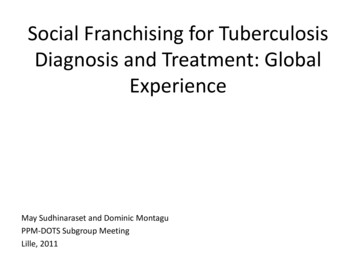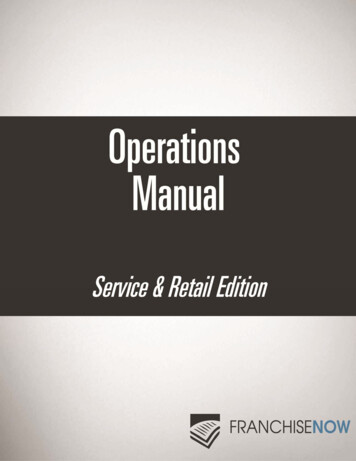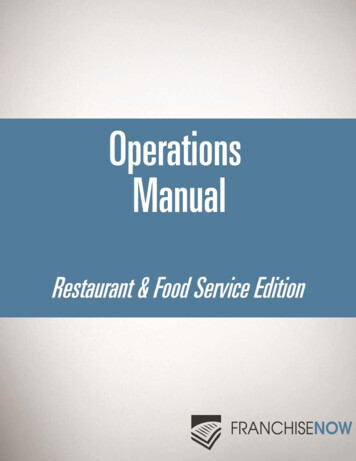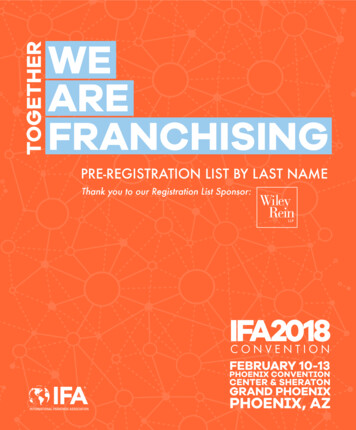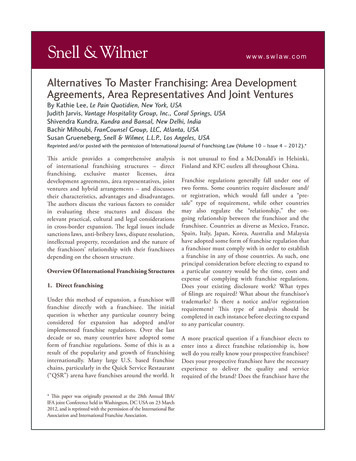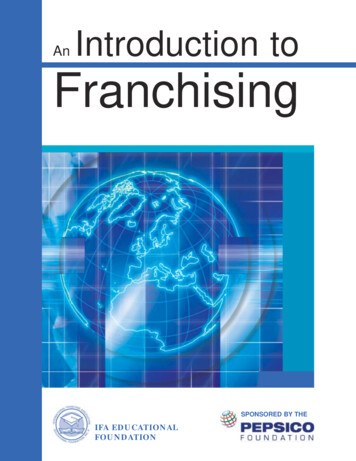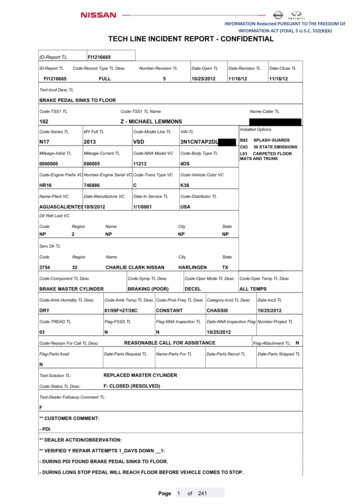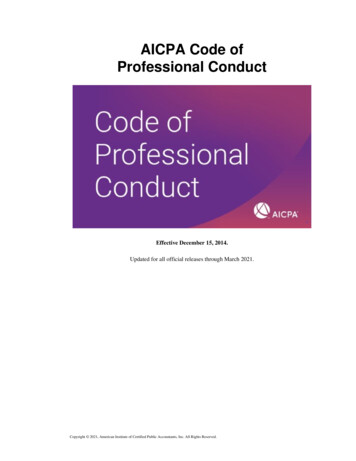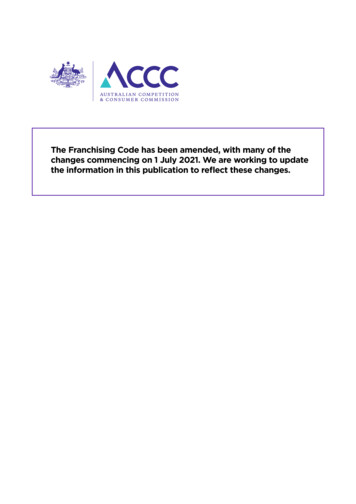
Transcription
The Franchising Code has been amended, with many of thechanges commencing on 1 July 2021. We are working to updatethe information in this publication to reflect these changes.
Franchising model disclosure documentThe following pages give a recommended format for a disclosure document for a franchisor to give toa franchisee or prospective franchisee in accordance with Annexure 1 of the Competition andConsumer (Industry Codes—Franchising) Regulation 2014 (the Code).This document has been created by the Australian Competition and Consumer Commission (ACCC)as guidance only. It does not constitute legal or other professional advice. We strongly recommendyou seek advice from professionals with experience in franchising on how to comply with yourdisclosure obligations and the information and documents you are required to provide and keep.This document is current as of 26 August 2019. It does not reflect change in the law after this date.What must be in a disclosure documentThe purpose of the disclosure document is to: give a prospective franchisee or a franchisee proposing to renew or extend the term or scopeof a franchise agreement information to help them make a reasonably informed decisionabout the franchise give a franchisee current information that is material to the running of their franchisedbusiness.You must ensure that all statements or representations made in your disclosure document (and otherdocuments) are true, accurate and able to be substantiated. It is against the law for businesses tomislead. Penalties may be imposed on you by a court, or the Australian Competition andConsumer Commission may issue an infringement notice with a penalty, if you do notadequately disclose information to prospective or current franchisees and/or if you misleadprospective or current franchisees in contravention of the Australian Consumer Law.There is a certain format for a disclosure document (which this guidance is designed to assist with).Under the Code subclauses 8(3) and 8(4) require that a disclosure document: be set out in the form and order of Annexure 1 of the Code use the headings and numbering of Annexure 1 of the Code be signed by the franchisor, or a director, officer or authorised agent of the franchisor.When a disclosure document must be givenYou are required to provide a disclosure document at least 14 days before the prospective franchiseeenters into the franchise agreement or an agreement to enter into one, or pays any non-refundablemoney. This document should also be provided with any other documents under clause 8 of theFranchising Code of Conduct (Code) (and as applicable, the other agreements referred to in clause14 of the Code).A current franchisee may also request in writing a copy of the disclosure document (once every 12months) and you are required to give this document within 14 days of their request, or if the disclosuredocument needs updating following application of the exemption in subclause 8(7) of the Code, thenwithin 2 months of the request. You must update the disclosure document so that it reflects theposition of the franchise as at the end of the financial year before the financial year in which therequest is made.When a disclosure document must be updatedYou are required to update the disclosure document within four months after the end of each financialyear. The Code defines ‘financial year’ as a period of 12 months in respect of which financialstatements relating to the franchise are prepared for the franchisor.You are not required to update the disclosure document at the end of the financial year if anexemption applies. Please refer to subclauses 8(7) and 8(8) of the Code.TIP: In order to ensure compliance with the requirement to provide details of the specified matters,information that is likely to be considered to be important and significantly relevant to a franchiseeabout the specified matter should be disclosed. If an item refers to details, sufficient details shouldbe provided to support the answer.1
TIP: The previous page and all content contained in box with red border or with red text isguidance by the ACCC and should not be included in your disclosure document. The contentbelow must be the first page of your disclosure document.TIP: When using this guidance you should increase table sizes as necessary.1.First page1.1 (a) DISCLOSURE DOCUMENT FOR FRANCHISEE OR PROSPECTIVE FRANCHISEE(b) the franchisor’s:(i) name; andClick here to enter text.(ii) business address; andClick here to enter text.phone number; andClick here to enter text.(iii) ABN, ACN or ARBN (or foreignequivalent if the franchisor is aforeign franchisor).Click here to enter text.(c)(d) Franchisor/director/officer/Date of preparationauthorised agent of the franchisorTIP: If you intend to send the disclosure document in electronic form you must obtain the consent ofthe prospective franchisee or franchisee to delivery in that format. You may then attach an electronicsignature.TIP: The following warning statement (e) must appear on the first page of the disclosure document.(e) This disclosure document contains some of the information you need in order to make an informeddecision about whether to enter into a franchise agreement. It should be read together with theinformation statement you have received.Entering into a franchise agreement is a serious undertaking. Franchising is a business and, like anybusiness, the franchise (or franchisor) could fail during the franchise term. This could haveconsequences for the franchisee.A franchise agreement is legally binding on you if you sign it.2
You are entitled to a waiting period of 14 days before you enter into this agreement.If this is a new franchise agreement (not the transfer or renewal of a franchise agreement, nor theextension of the term or the scope of a franchise agreement), you will be entitled to a 7 day “coolingoff” period after signing the agreement, during which you may terminate the agreement.If you decide to terminate the agreement during the cooling off period, the franchisor must, within 14days, return all payments (whether of money or of other valuable consideration) made by you to thefranchisor under the agreement. However, the franchisor may deduct from this amount the franchisor’sreasonable expenses, if the expenses or their method of calculation have been set out in theagreement.Take your time, read all the documents carefully, talk to other franchisees and assess your ownfinancial resources and capabilities to deal with the requirements of the franchised business.You should make your own enquiries about the franchise and about the business of the franchise.You should get independent legal, accounting and business advice before signing the franchiseagreement.It is often prudent to prepare a business plan and projections for profit and cash flow.You should also consider educational courses, particularly if you have not operated a business before.3
Table of Contents1.First page . 22.Franchisor details . 53.Business experience. 74.Litigation . 85.Payments to agents . 116.Existing franchises . 117.Master franchises. 148.Intellectual property . 169.Franchise site or territory . 1710. Supply of goods or services to a franchisee. 1811. Supply of goods or services by a franchisee . 2112. Supply of goods or services—online sales . 2113. Sites or territories . 2214. Other payments . 2315. Marketing or other cooperative funds . 2716. Financing . 2817. Unilateral variation of franchise agreement . 2918. Arrangements to apply at the end of the franchise agreement. 2919. Amendment of franchise agreement on transfer of franchise . 3120. Earnings information . 3121. Financial details . 3222. Updates . 3423. Receipt . 34Annexures:Click here to enter text.TIP: The numbering and headings of the items in the disclosure document must remain the same.If a particular item in the disclosure document is not applicable, it should either be noted as notapplicable in the body of the disclosure document or you can chose to remove this item from thebody of the disclosure document and note it in an attachment to the disclosure document.TIP: Any annexures or attachments to the disclosure document must be listed in the table ofcontents in order of appearance. Relevant annexures may include the Code; site or territoryhistory item 13); earnings information (item 20); financial details (item 21); and franchiseagreement.If your disclosure document refers to a clause in your franchise agreement, then the franchiseagreement should be provided with it or it should be attached as an annexure to the disclosuredocument (including if a franchisee has requested a current disclosure document pursuant toclause 16 of the Code).However, for some disclosure items it may be insufficient disclosure to merely refer to a clause ina franchise agreement or other documents such as an operation manual (item 10.1 for example).4
TIP: Remember, when using this guidance you should increase table sizes as necessary.2.Franchisor details2.1The franchisor’s:2.2(a) name; andClick here to enter text.(b) address, or addresses, of franchisor’sregistered office and principal place ofbusiness in Australia; andClick here to enter text.(c) ABN, ACN or ARBN (or foreignequivalent if the franchisor is a foreignfranchisor).Click here to enter text.The name under which the franchisor carries on business in Australia relevant to thefranchise:Click here to enter text.2.3A description of the kind of business operated under the franchise:Click here to enter text.2.4The number of years that the franchise or franchise system has operated in Australia:Click here to enter text.TIP: An ‘associate’ means a persona) who:i. is a director or related entity of the franchisor, or a director of a related bodycorporate; orii. for a franchisor that is a proprietary company - directly or indirectly owns, controls, orholds with power to vote, at least 15 per cent of the issued voting shares in thefranchisor; oriii. is a partner of the franchisor; andb) whose relationship with the franchisor is relevant to the franchisee system, includingbecause:i. the person supplies goods or services to a franchisee; orii. the person gives the franchisee a right to occupy the premises, whether under alease or otherwise; oriii. the person owns intellectual property used in the franchise system; oriv. the person is involved in market research, market testing, market development, salespromotion or management of the franchise system.2.5The name, ABN, ACN or ARBN, address of registered office and principal place of business ofeach associate of the franchisor that is a body corporate (if any):NameClick here to enter text.ABN, ACN or ARBNClick here to enter text.5
2.6Address of registered officeClick here to enter text.Principal place of businessClick here to enter text.NameClick here to enter text.ABN, ACN or ARBNClick here to enter text.Address of registered officeClick here to enter text.Principal place of businessClick here to enter text.The name and address of each associate of the franchisor that is not a body corporate (ifany), and if applicable, each associate’s ABN or ARBN:NameClick here to enter text.ABN or ARBNClick here to enter text.AddressClick here to enter text.NameClick here to enter text.ABN or ARBNClick here to enter text.AddressClick here to enter text.TIP: For example, this includes the directors of the franchisor entity and directors ofcorporate associates of the franchisor. This could include associates who may be trustees.If you are unsure who to include you should seek legal advice.2.7A description of the relationship between:(a) each associate mentioned in item 2.5 and the franchisor; and(b) each associate mentioned in item 2.6 and the franchisor;and the relevance of the relationship to the franchise system and the franchise:Click here to enter text.6
2.8For each officer of the franchisor—name, position held and qualifications (if any):TIP: The term ‘officer’ has the meaning given by the Corporations Act 2001 and willinclude: a director or secretary of a corporation an administrator of the corporation if the entity is an unincorporated association an office holder if the franchisor is a partnership a partner a person:owho makes or participates in making decisions that affect the whole or asubstantial part of the entity’s business; orowho has the capacity to significantly affect the entity’s financial standingSee the Corporations Act 2001 for a complete definition of ‘officer’.If you are in any doubt about whether a particular person is an officer, you should seeklegal advice.While you should make your own assessment, an ‘officer’ may include Chief ExecutiveOfficer, Chief Operating Officer, Chief Financial Officer.NameClick here to enter text.Position heldClick here to enter text.QualificationsClick here to enter text.NameClick here to enter text.Position heldClick here to enter text.QualificationsClick here to enter text.NameClick here to enter text.Position heldClick here to enter text.QualificationsClick here to enter text.3.Business experience3.1A summary of the relevant business experience of each person mentioned in item 2.8 for thepast 10 years, including length of experience in:(a) working in the franchise system; andClick here to enter text.(b) working for the franchisor.Click here to enter text.7
TIP: You should include information regarding all business activities undertaken by thefranchisor. This includes both successful and unsuccessful business activities.In Australian Competition and Consumer Commission v Morild Pty Ltd [2017] FCA 1308,the Federal Court found that Morild (which operated the ‘Pastacup’ franchise system)had failed to disclose that the company’s co-founder and former director was previouslya director of two former Pastacup franchisors that each became insolvent.The Court held that this was relevant business experience that was required to bedisclosed to prospective franchisees in the Pastacup disclosure document. The FederalCourt ordered Morild to pay 100 000 and its former director 50 000 in penalties forbreaches of the Code.3.2A summary of relevant business experience of the franchisor for the past 10 years, including:(a) length of experience in:(i) operating a business that issubstantially the same as that of thefranchise; andClick here to enter text.(ii) offering other franchises that aresubstantially the same as thefranchise; andClick here to enter text.(b) whether the franchisor has offeredfranchises for other businessesIf yes to (b):Click here to enter text.(i) a description of each suchbusiness; and(ii) for how long the franchisoroffered franchises for each suchbusiness.4.Litigation4.1Details of:Click here to enter text.(a) current proceedings by a public agency, criminal or civil proceedings or arbitration,relevant to the franchise, against the franchisor, a franchisor director, an associate of thefranchisor or a director of an associate of the franchisor, in Australia alleging:(i) breach of a franchise agreement; or(ii) contravention of trade practices law; orTIP: This includes a contravention of theCompetition and Consumer Act 2010, apart of which is the Australian ConsumerLaw.(iii) contravention of the Corporations Act 2001; or(iv) unconscionable conduct; or8
(v) misconduct; orTIP: The term ‘misconduct’ has themeaning given by Corporations Act 2001and includes fraud, negligence, default,breach of trust and breach of duty.(vi) an offence of dishonesty; and(b) proceedings against the franchisor, a franchisor director, an associate of the franchisoror a director of an associate of the franchisor, other than for unfair dismissal of anemployee, under:(i) section 12 of the Independent Contractors Act2006; or(ii) a law of a State or Territory that regulatesworkplace relations or independent contractors.TIP: This includes any proceedings undersection 558B of the Fair Work Act 2009.4.2Whether the franchisor, a franchisor director, an associate of the franchisor or a director of anassociate of the franchisor, has been:(a) in the last 10 years—convicted of a serious offence, or anequivalent offence outside Australia; orTIP: A ‘serious offence’ is defined in clause 4 ofthe Code as:(a) an offence under any law of theCommonwealth or a State or a Territory for which,if the act or omission had taken place in the JervisBay Territory, a person would be liable, on firstconviction, to imprisonment for a period of not lessthan 5 years; or(b) a contravention of any provision of theCorporations Act 2001.Note: Jervis Bay Territory is mentioned because itis a jurisdiction in which the Commonwealth hascontrol over the criminal law.(b) in the last 5 years—subject to final judgment in civilproceedings for a matter mentioned in paragraph 4.1(a); or(c) in the last 10 years—bankrupt, insolvent underadministration or a Chapter 5 body corporate in Australia orelsewhere.9
TIP: ‘Chapter 5 body corporate’ is defined in theCorporations Act 2001 as a body corporate:(a) that is being wound up; or(b) in respect of property of which a receiver, or areceiver and manager, has been appointed(whether or not by a court) and is acting; or(c) that is under administration; or(d) that has executed a deed of companyarrangement that has not yet terminated; or(e) that has entered into a compromise orarrangement with another person theadministration of which has not been concluded.4.3For items 4.1 and 4.2—the following details (where relevant):(a) the names of the parties to the proceedings;Click here to enter text.(b) the name of the court, tribunal or arbitrator;Click here to enter text.(c) the case number;Click here to enter text.(d) the general nature of the proceedings;Click here to enter text.(e) the current status of the proceedings;Click here to enter text.(f) the date and content of any undertaking or orderunder section 87B of the Competition and ConsumerAct 2010;Click here to enter text.(g) the penalty or damages assessed or imposed;Click here to enter text.(h) the names of the persons who are bankrupt,insolvent under administration or externallyadministered;Click here to enter text.TIP: There are two ways a person canbecome bankrupt: a creditor makes an application tocourt to declare the person bankrupt the person lodges an application tobecome bankrupt.TIP: The Corporations Act 2001 providesa definition of ‘insolvent underadministration’. It includes a person whohas executed a personal insolvencyagreement under Part X of the BankruptcyAct 1966, or is an undischarged bankrupt,or whose property is subject to controlunder section 50 or Division 2 of Part X ofthe Bankruptcy Act 1966.10
TIP: External administration includesadministration, receivership andliquidation.(i) the period of the bankruptcy, insolvency underadministration or external administration.Click here to enter text.5.Payments to agents5.1For any agreement under which the franchisor must pay an amount, or give other valuableconsideration, to a person who is not an officer, director or employee of the franchisor inconnection with the introduction or recruitment of a franchisee—the name of the person:Click here to enter text.TIP: This may include payments to a franchisee when referring someone to the franchise orgifts to another business for promoting the recruitment of franchisees to your franchise.Examples of such payments may include payments to a franchise consultant, estate agent,broker or other advisor.6.Existing franchises6.1Number, sorted by State, Territory or region, of:(a) existing franchised businesses; and(b) existing franchisees; and(c) businesses owned or operated by the franchisor or an associate of the franchisor inAustralia that are substantially the same as the franchised business:State/Territory/region(a) existingfranchisedbusinesses;and(b) existingfranchisees;and(c) businesses owned oroperated by the franchisor or anassociate of the franchisor inAustralia that are substantiallythe same as the franchisedbusiness.NSWClick here toenter text.Click here toenter text.Click here to enter text.VicClick here toenter text.Click here toenter text.Click here to enter text.QldClick here toenter text.Click here toenter text.Click here to enter text.SAClick here toenter text.Click here toenter text.Click here to enter text.WAClick here toenter text.Click here toenter text.Click here to enter text.TasClick here toenter text.Click here toenter text.Click here to enter text.ACTClick here toenter text.Click here toenter text.Click here to enter text.NTClick here toClick here toClick here to enter text.11
TOTALenter text.enter text.Click here toenter text.Click here toenter text.Click here to enter text.TIP: This is the number of franchises in the system at the preparation date the disclosuredocument is dated.6.2For each existing franchisee:(a) business address, if this isnot the franchisee’s residentialaddress; and(b) business phonenumber; and(c) year when the franchiseestarted operating thefranchised business.Click here to enter text.Click here to enter text.Click here to enter text.Click here to enter text.Click here to enter text.Click here to enter text.TIP: Remember, when using this guidance you should increase table sizes asnecessary.6.36.4However, if there are more than 50 franchises, the franchisor may instead give details underitem 6.2 for all franchisees in the State, Territory, region or metropolitan area in which thefranchise is to be operated:(a) business address, if thisis not the franchisee’sresidential address; and(b) business phonenumber; and(c) year when the franchiseestarted.Click here to enter text.Click here to enter text.Click here to enter text.Click here to enter text.Click here to enter text.Click here to enter text.For each of the last 3 financial years and for each of the following events—the number offranchised businesses for which the event happened:TIP: Insert relevant financial years.Details of events of each of thelast three yearsYear 1Year 2Year d/mm/yyyyPeriod:dd/mm/yyyytodd/mm/yyyy(a) the franchise was transferred;Click here toenter text.Click here toenter text.Click here toenter text.(b) the franchised businessceased to operate;Click here toenter text.Click here toenter text.Click here toenter text.(c) the franchise agreement wasterminated by the franchisor;Click here toenter text.Click here toenter text.Click here toenter text.(d) the franchise agreement wasterminated by the franchisee;Click here toenter text.Click here toenter text.Click here toenter text.(e) the franchise agreement wasnot extended;Click here toenter text.Click here toenter text.Click here toenter text.12
(f) the franchised business wasbought back by the franchisor;Click here toenter text.Click here toenter text.Click here toenter text.(g) the franchise agreement wasterminated and the franchisedbusiness was acquired by thefranchisor.Click here toenter text.Click here toenter text.Click here toenter text.NOTE: An event may be counted more than once if more than one paragraph applies.6.5Subject to subclause 32(1), the franchisor must supply, for each event mentioned in item 6.4the name, location and contact details of each franchisee if the information is available:TIP: Remember, when using this guidance you should increase table sizes as necessary.TIP: You should provide useful contact information for former franchisees, such as anemail address and phone number.It is unlikely to be sufficient to only provide the former business address and businessphone number used by previous franchisees as they no longer operate the franchise.Former franchisee contact details must be included unless a request in writing is made bya former franchisee that their details not to be disclosed to a prospective franchisee undersubclause 32(1) of the Code.You must not attempt to influence the former franchisee to make such a request.Doing so is a breach of subclause 32(3) of the Code and penalties apply.Year 1Period: dd/mm/yyyy to dd/mm/yyyyEvent: Click here to enter text.NameLocationContact detailsClick here to enter text.Click here to enter text.Click here to enter text.Click here to enter text.Click here to enter text.Click here to enter text.NameLocationContact detailsClick here to enter text.Click here to enter text.Click here to enter text.Click here to enter text.Click here to enter text.Click here to enter text.Event: Click here to enter text.Year 2Period: dd/mm/yyyy to dd/mm/yyyyEvent: Click here to enter text.NameLocationContact detailsClick here to enter text.Click here to enter text.Click here to enter text.Click here to enter text.Click here to enter text.Click here to enter text.Event: Click here to enter text.13
NameLocationContact detailsClick here to enter text.Click here to enter text.Click here to enter text.Click here to enter text.Click here to enter text.Click here to enter text.Year 3Period: dd/mm/yyyy to dd/mm/yyyyEvent: Click here to enter text.NameLocationContact detailsClick here to enter text.Click here to enter text.Click here to enter text.Click here to enter text.Click here to enter text.Click here to enter text.NameLocationContact detailsClick here to enter text.Click here to enter text.Click here to enter text.Click here to enter text.Click here to enter text.Click here to enter text.Event: Click here to enter text.7.Master franchisesTIP: A master franchise is usually a system where the ‘master franchisor’ grants anotherparty (the subfranchisor), control over the franchising activities in an area (for example, inAustralia or a particular State or Territory). Normally, the subfranchisor then enters intofranchise agreements with individual franchisees to grant them a subfranchise.7.17.2If the franchisor is also a subfranchisor—the master franchisor’s:(a) name; andClick here to enter text.(b) address, or addresses, of registered office andprincipal place of business; andClick here to enter text.(c) ABN, ACN or ARBN (or foreign equivalent ifapplicable).Click here to enter text.The name under which the master franchisor carries on business relevant to the franchise:Click here to enter text.7.3For each officer of the master franchisor—name, position held and qualifications (if any):NameClick here to enter text.Position heldClick here to enter text.QualificationsClick here to enter text.NameClick here to enter text.14
7.4Position heldClick here to enter text.QualificationsClick here to enter text.For each of the last 3 financial years and each of the following events—thenumber of:TIP: Specify each financial year.Details of events of each of the last 3 years;Year 1Year 2Year 3Period:dd/mm/yyyy todd/mm/yyyyPeriod:dd/mm/yyyy todd/mm/yyyyPeriod:dd/mm/yyyy todd/mm/yyyy(a) franchise agreements terminated by themaster franchisor;Click here toenter text.Click here toenter text.Click here toenter text.(b) franchise agreements terminated by thefranchisor;Click here toenter text.Click here toenter text.Click here toenter text.(c) franchise agreements that were notextended by the master franchisor.Click here toenter text.Click here toenter text.Click here toenter text.NOTE: An event may be counted more than once if more than one paragraph applies.7.5The following details about the master franchise:(a) the term of the franchise agreement, includingthe date that it began;Click here to enter text.(b) the territory of the franchise;Click here to enter text.(c) whether the franchise agreement may berenewed;Click here to enter text.TIP: Renewal is when the franchiseeexercises an option during the term of theagreement to renew the agreement.(d) whether the term of the franchise agreement maybe extended and if so, any preconditions applying toan extension;Click here to enter text.TIP: In the context of paragraph (d), theterm of agreement is ‘extended’ when theperiod of the agreement is extended, otherthan because of a right or an optionexerci
1 Franchising model disclosure document The following pages give a recommended format for a disclosure document for a franchisor to give to a franchisee or prospective franchisee in accordance with Annexure 1 of the Competition and Consumer (Industry Codes—Franchising) Regulation 2014 (the Code). This
